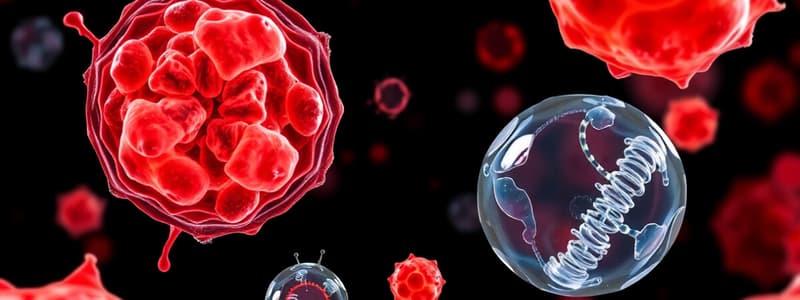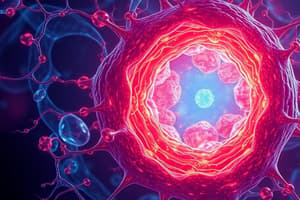Podcast
Questions and Answers
What are the three parts of the Cell Theory?
What are the three parts of the Cell Theory?
- All organisms are multicellular, cells are the structural unit of life, cells can survive independently.
- Cells form tissues, all cells have a nucleus, cells must have mitochondria.
- Cells can arise spontaneously, cells have no structure, all organisms consist of tissues.
- All organisms are made of cells, cells are the basic unit of life, all cells come from pre-existing cells. (correct)
Which of the following features is unique to eukaryotic cells compared to prokaryotic cells?
Which of the following features is unique to eukaryotic cells compared to prokaryotic cells?
- Genetic Material
- Cell Membrane
- Mitochondria (correct)
- Ribosomes
What is the function of the centriole in a cell?
What is the function of the centriole in a cell?
- Synthesizes ribosomal RNA
- Facilitates cell division by organizing the spindle fibres (correct)
- Conducts photosynthesis
- Stores digestive enzymes
Which of the following cells is primarily involved in oxygen transport in the human body?
Which of the following cells is primarily involved in oxygen transport in the human body?
Which type of cell undergoes a process called differentiation?
Which type of cell undergoes a process called differentiation?
What are the three main components of the circulatory system?
What are the three main components of the circulatory system?
Which muscle tissue is specifically found in the heart?
Which muscle tissue is specifically found in the heart?
Which is the correct order that blood flows through the chambers of the heart?
Which is the correct order that blood flows through the chambers of the heart?
What distinguishes arteries from veins?
What distinguishes arteries from veins?
Which of the following is NOT one of the four major elements of blood?
Which of the following is NOT one of the four major elements of blood?
What condition is characterized by a blockage of an artery that prevents blood flow to heart muscle?
What condition is characterized by a blockage of an artery that prevents blood flow to heart muscle?
Which system is primarily affected by diabetes?
Which system is primarily affected by diabetes?
In which part of the body does the myelin sheath primarily function?
In which part of the body does the myelin sheath primarily function?
Which organelle is primarily responsible for producing energy for the cell?
Which organelle is primarily responsible for producing energy for the cell?
What is the primary function of ribosomes?
What is the primary function of ribosomes?
During which phase of the cell cycle does DNA replication occur?
During which phase of the cell cycle does DNA replication occur?
What distinguishes benign tumors from malignant tumors?
What distinguishes benign tumors from malignant tumors?
Which structure is responsible for protecting and maintaining the shape of plant cells?
Which structure is responsible for protecting and maintaining the shape of plant cells?
What is one requirement for gas exchange to occur in the lungs?
What is one requirement for gas exchange to occur in the lungs?
What is the primary role of the Golgi apparatus in a cell?
What is the primary role of the Golgi apparatus in a cell?
Which type of cell is primarily responsible for oxygen transport in the body?
Which type of cell is primarily responsible for oxygen transport in the body?
What is the defining characteristic of stem cells?
What is the defining characteristic of stem cells?
Which phase of mitosis involves the separation of sister chromatids?
Which phase of mitosis involves the separation of sister chromatids?
What is the main function of villi in the small intestine?
What is the main function of villi in the small intestine?
What are carcinogens known for?
What are carcinogens known for?
What is mechanical digestion?
What is mechanical digestion?
Which nutrient is primarily used by the body for energy?
Which nutrient is primarily used by the body for energy?
Flashcards
Prokaryote
Prokaryote
A single-celled organism without a nucleus or other membrane-bound organelles.
Eukaryote
Eukaryote
An organism with complex cells containing a nucleus and other membrane-bound organelles.
Cell Theory (3 parts)
Cell Theory (3 parts)
- All organisms are made of cells, 2. All cells come from pre-existing cells, 3. Cells are the basic unit of structure and function in living organisms.
Prokaryote vs. Eukaryote
Prokaryote vs. Eukaryote
Signup and view all the flashcards
Common Cell Features (Prokaryotic and Eukaryotic)
Common Cell Features (Prokaryotic and Eukaryotic)
Signup and view all the flashcards
Organelles
Organelles
Signup and view all the flashcards
Cell Membrane
Cell Membrane
Signup and view all the flashcards
Cytoplasm
Cytoplasm
Signup and view all the flashcards
Mitochondria
Mitochondria
Signup and view all the flashcards
Ribosomes
Ribosomes
Signup and view all the flashcards
Endoplasmic Reticulum
Endoplasmic Reticulum
Signup and view all the flashcards
Golgi Body
Golgi Body
Signup and view all the flashcards
Nucleus
Nucleus
Signup and view all the flashcards
Vacuoles
Vacuoles
Signup and view all the flashcards
Cell Wall
Cell Wall
Signup and view all the flashcards
Chloroplasts
Chloroplasts
Signup and view all the flashcards
Cell Division
Cell Division
Signup and view all the flashcards
Interphase
Interphase
Signup and view all the flashcards
Mitosis
Mitosis
Signup and view all the flashcards
Cytokinesis
Cytokinesis
Signup and view all the flashcards
Heart Chambers (Order)
Heart Chambers (Order)
Signup and view all the flashcards
Arteries vs. Veins
Arteries vs. Veins
Signup and view all the flashcards
Blood Components
Blood Components
Signup and view all the flashcards
Digestive & Circulatory System
Digestive & Circulatory System
Signup and view all the flashcards
Circulatory & Respiratory
Circulatory & Respiratory
Signup and view all the flashcards
Respiratory & Musculoskeletal
Respiratory & Musculoskeletal
Signup and view all the flashcards
Musculoskeletal & Nervous
Musculoskeletal & Nervous
Signup and view all the flashcards
Diabetes (Organ System)
Diabetes (Organ System)
Signup and view all the flashcards
Study Notes
Prokaryotic and Eukaryotic Cells
-
Prokaryotes lack membrane-bound organelles.
-
Eukaryotes possess membrane-bound organelles.
-
Both prokaryotic and eukaryotic cells share a cell membrane, genetic material, ribosomes, and cytoplasm.
Cell Theory
- All organisms are made of cells.
- Cells come from pre-existing cells.
- Cells are the structural and functional units of life.
Cell Cycle
- Interphase: Cell growth, DNA replication, and preparation for division.
- G1 Phase: Cell growth and preparation for DNA replication.
- S Phase: DNA replicates; two copies of chromosomes are formed.
- G2 Phase: Further cell growth, checks for readiness for division.
- Mitosis: Cell division resulting in two identical daughter cells.
- Prophase: Breakdown of nuclear envelope, spindle fiber formation, DNA condenses into chromosomes, and sister chromatids join at the centromere.
- Metaphase: Chromosomes align at the metaphase plate.
- Anaphase: Sister chromatids separate and move to opposite poles.
- Telophase: Nuclear envelope reforms, chromosomes decondense, and cleavage furrow forms.
- Cytokinesis: Cytoplasm and plasma membrane divide, forming two daughter cells.
Cell Structures
- Chromosome: Thread-like DNA structure carrying genetic information.
- Chromatin: DNA and protein complex for packaging and gene regulation.
- Sister Chromatids: Two identical copies of a replicated chromosome, joined at the centromere.
- Centromere: Region where sister chromatids are joined and spindle fibers attach.
- Organelles: Sub-cellular structures with specific functions.
- Nucleus: Controls cell activities.
- Mitochondria: Powerhouses of the cell, generate energy.
- Ribosomes: Assemble proteins.
- Endoplasmic Reticulum: Synthesizes and transports proteins and lipids.
- Vesicles: Transport materials within the cell.
- Golgi Body: Packages and exports proteins.
- Vacuoles: Storage structures.
- Cytoskeleton: Maintains cell shape and organelle position.
- Cell Wall: Provides strength and protection (plant cells).
- Chloroplasts: Conduct photosynthesis (plant cells).
- Cell Membrane: Barrier for cell (enters and exits).
- Cytoplasm: Substance that fills the cell, and keeps organelles in place.
- Lysosomes: Digestive sacs of the cell.
- Centrioles: Involved in cell division.
Cancer
- Cancer is caused by uncontrolled cell growth.
- Benign tumor: Non-cancerous; does not spread.
- Malignant tumor: Cancerous; invades surrounding tissues and spreads (metastasis.)
- Metastasis: Cancer cells detach from primary tumor, travel in the bloodstream or lymphatic system, and form secondary tumors elsewhere.
- Carcinogen: Cancer-causing substance. Examples: alcohol, arsenic, UV rays, diesel exhaust, tobacco.
Specialized Cells
- Specialized cells have unique structures and functions.
- Sperm: Fertilization.
- Red Blood Cells: Oxygen transport.
- Egg Cells: Development.
- Villi: Nutrient absorption.
Tissues, Organs, and Organ Systems
- Tissue: Group of similar cells performing a specific function.
- Organ: Group of tissues working together for a common function.
- Organ System: Multiple organs functioning together for a complex function.
- Levels of Organization (smallest to largest): Organelles, cells, tissues, organs, organ systems, organism
Digestive System
- Mechanical digestion: Physical breakdown of food.
- Chemical digestion: Enzyme breakdown of food.
- Accessory organs: Liver, gallbladder, pancreas.
Respiratory System
- Gas exchange: Oxygen and carbon dioxide exchange between alveoli and capillaries.
- Factors for efficient gas exchange include a large surface area for exchange and a thin diffusion distance.
Circulatory System
- Components: Heart, blood, blood vessels.
- Heart Chambers (blood flow order): Right atrium, right ventricle, left atrium, left ventricle.
- Arteries: Carry blood away from the heart.
- Veins: Carry blood to the heart.
- Blood Components: Red blood cells (oxygen transport), white blood cells (immune function), platelets (blood clotting), plasma (liquid component).
Musculoskeletal System
- Muscles: Move the body.
- Bones: Support and protect the body.
Nervous System
- Central nervous system (CNS): Brain and spinal cord.
- Peripheral nervous system (PNS): Nerves connecting CNS to body parts.
- Neuron: Nerve cell.
Interactions Between Organ Systems
- Digestive and circulatory: Breakdown of food fuels travel in circulation.
- Circulatory and respiratory: Oxygenated blood flows to tissues from lungs; return with carbon dioxide.
- Respiratory and musculoskeletal: Muscles (diaphragm) facilitate breathing.
- Musculoskeletal and nervous: Muscles are controlled by nerves.
Studying That Suits You
Use AI to generate personalized quizzes and flashcards to suit your learning preferences.




